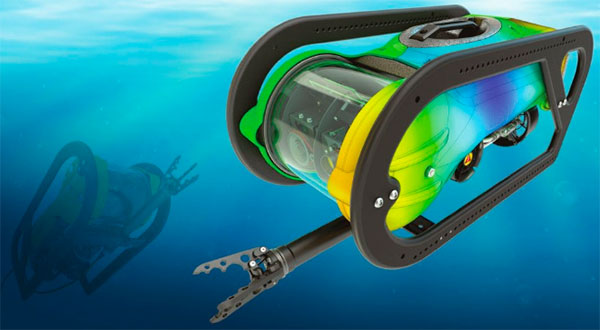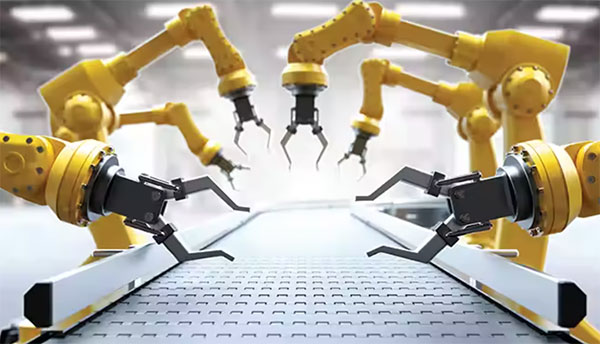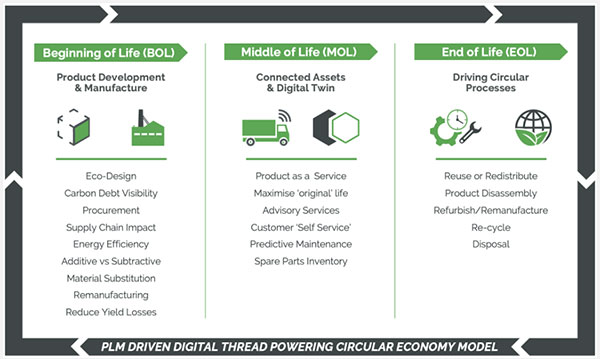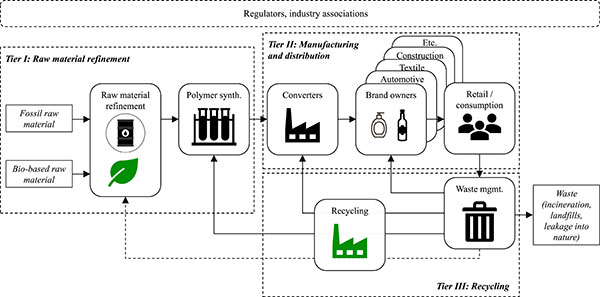Plastics Design Challenges in Age of Sustainability
It is critical that sustainability is on the agenda at the very earliest stages of product development.

SolidWorks Plastics is one example of many products from engineering software vendors, retasked to take on new challenges. It can be used to help design for sustainability as well as manufacturability. Image courtesy of Dassault Systèmes.
Latest News
November 9, 2022
Humanity has a love-hate relationship with plastics unlike any other fabrication material. We use it in vast quantities in almost every aspect of our lives. Yet we now know the versatility and ubiquity of plastic comes with a heavy price. There are charted “islands” in the oceans of drifting plastics that the current gathers. Micro particles are in our food, animals and bodies. Plastics have become a leading cause of environmental degradation.
Two related concepts for the future of plastics—sustainability and circularity—are now being widely studied and debated, specifically within product development and manufacturing.
Sustainability refers to the ability for society to meet its needs without compromising the ability of future generations to meet their own needs. Manufacturers are feeling the pressure from all directions to create products that use less materials, choose materials that can be recycled or replaced and make products in a way that uses less energy and lowers emissions.
The term “needs” is evolving as consumers become more interested in sustainability. Instead of saying, “I need a soft and strong cover for my cellphone in my favorite color,” more consumers are saying “I need my new cellphone cover to be completely recyclable—and I need it to be soft and strong in my favorite color.”
Circularity—a subset of sustainability—is the ability to put plastics back into the supply chain instead of disposing it as waste. There are two methods for turning old plastic into new plastic. The first is mechanical processing. Old plastic is processed to divide different kinds of plastic and to separate it from nonplastics. The resulting harvested material is then reformed into new products.
The second way to reuse plastics is chemical processing—changing the chemical structure of polymerics. Though it may sound like a great idea, most chemical processing is at the R&D or pilot stage.

Bain & Company estimates less than 30 kilotons of plastic (mostly polyolefins) are now chemically recycled annually. Research is focused not only on creating reusable materials, but on processes that are environmentally sound.
Biodegradability is gaining ground as a research topic that covers both bases. Companies look to introduce new plastics that mimic natural materials that will either disintegrate over time, be easily composted or quickly remanufactured for reuse. As with other plastics, new biodegradable materials will have to pass the same triple bottom line test being applied to other plastics: economic profit, social responsibility and environmental protection.
Design for Sustainability
To succeed, sustainability must be on the agenda at the very earliest stages of product development, using what researchers call a circular design model. Ludovic Dumée, a chemical engineering researcher at Khalifa University, United Arab Emirates, is a leading proponent of circular design.
“The implementation of innovative circular design and production strategies will not only benefit society but also offer opportunities for companies by positively affecting economic growth, reducing negative impact on the environment, renewing the job market through innovation and helping improve the image and recognition linked to their core values and missions,” he says.
Engineers often view themselves agents of change, but real change that leads to design for sustainability really starts in the executive suite. As Dumée notes, new business models are required that provide funding for use of alternative or recycled plastics. Alternative sourcing methods must be prioritized such as novel recomposition of raw elements and strategies such as design for eventual dismantling must be embraced as corporate policy.
Individual companies need to think globally not only about sales but also about sourcing.
“Redesigning materials with the entire life cycle of the product in mind must be carried out by manufacturers at a global scale,” says Dumée. “Designers and engineers shall work with more drastic and complex specifications to enable this circular design. Markets and consumers are demanding such changes both from a moral perspective and a long-term vision point of view.”
Sometimes sustainability goals seem to be in competition; leadership will need to sort it out. Electric vehicles (EVs) are a hot topic in automotive, yet the materials required to make the batteries often come from toxic mining and refining methods; recycling these products and their casings is equally nasty. According to Dumée, “Novel strategies must be developed to ensure safe operation while facilitating the recovery of all valuable resources.”
Starting From Ground Zero
“Design for sustainability is starting from ground zero,” says Mohan Hrishikesh. As consumer goods industry director at Dassault Systèmes, Hrishikesh takes lead on researching and explaining sustainability and design.
“The whole concept of design is to optimize for performance. Whether it is a car or a toy, the design concept must think about the whole journey, from design onward,” he says.

Such whole systems design thinking is bigger than the purchased product. Considering the use of additive manufacturing as a way to achieve sustainability goals may be an option, but only if all the details are taken into consideration.
“Does the design account for support struts?” asks Hrishikesh. “If you print 10,000 of them, you have to accommodate the extras. How easily can you recycle it? Even the supports? Once you have the solutions upfront, it makes the journey easier.”
Hrishikesh says the complexity of design for sustainability is one reason the entire engineering software industry is putting digital twin technology front and center.
“You can’t do things by trial and error anymore,” he says. “All these things can be done in the virtual twin to help the journey. These are complex issues; you need more than simple tools to solve the problem, you need advanced [digital] twin technology. It is an absolute necessity.”
The digital twin is not just a design model, it is the virtual representation of every aspect of the product. “It used to be simple to design a bottle,” notes Hrishikesh. “Get a copy of SolidWorks and spin it up, then do some simple simulation” focused on fit for purpose and manufacturability.
Those days are gone, Hrishikesh notes. He cites candy maker Mars, a Dassault customer. They recently brought out a new packaging material to protect chocolate during shipment. Traditionally, they might have to load a truck with 10,000 bars, testing each new material.
“Now they simulate with the [digital] twin, and can do [complete testing] in one or two trips,” he says.
Additive Manufacturing Edge
3D printing often enters conversations about sustainability and circularity, as if it is the new magic bullet to solve the world’s problems. Additive manufacturing is only a method—the benefit lies in how it is used. Part consolidation is emerging as a major reason to use it more in manufacturing plastic parts.
Researchers at McGill University studied the creation of a multi-piece automotive part, as a generic example to study the differences between conventional design/manufacturing and Design for Additive Manufacturing (DfAM) to add part consolidation techniques. They concluded DfAM can be more environmentally friendly. Specifically, product lifespan can be improved by more than 200% if weight savings of at least 30% is achieved.
The creation of novel parts eliminates many joining processes, a substantial generator of material waste and carbon dioxide. Less tooling reduces the environmental burden. The research team noted these advantages, citing previous studies showing 80% of a product’s environmental damage is established after 20% of the design activity is complete.
Collaboration and Sustainability
“Collaborative” has become a mantra for engineering software companies in recent years. Researchers say any breakthroughs in transforming the use of plastics in product development will have to be collaborative. Two Finnish researchers, Jaakko Siltaloppi and Markus Jähi, foresee a new plastics value chain based on “collaborative infrastructure development.”

The researchers have identified four solution mechanisms:
- A shift from bulk materials to custom material solutions.
- A shift from firm-centric material development to cross-tier collaboration.
- A shift from price competition to sustainability benefits competition.
- A shift from isolated technologies to infrastructure development.
“These findings extend our understanding of the systemic challenges for the transition to a sustainable plastics economy and shed new light on the ways in which companies can address the challenges for a system-wide impact,” the two researchers report.
The technical and operational challenges are daunting, according to the researchers. Recycled plastics and new bio-based replacements have “inferior material properties,” which must be improved. There are no value streams in place to recycle or reuse these new materials. Brand owners and manufacturers lack competency in procurement and design using these materials. A circularity value chain for reuse “remains limited and unfavorably priced.”
Subscribe to our FREE magazine, FREE email newsletters or both!
Latest News
About the Author
Randall S. Newton is principal analyst at Consilia Vektor, covering engineering technology. He has been part of the computer graphics industry in a variety of roles since 1985.
Follow DE




